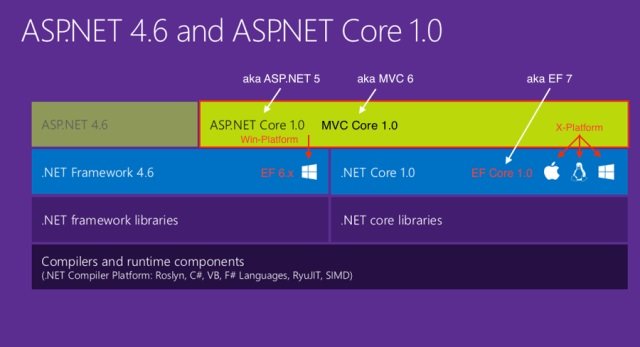Using EF6 with ASP.NET MVC Core 1.0 (aka MVC 6)
This week Microsoft announced that it is renaming ASP.NET 5 to ASP.NET Core 1.0. In general I think this is a very good step. Incrementing the version number from 4 to 5 for ASP.NET gave the impression that ASP.NET 5 was a continuation of the prior version and that a clean migration path would exist for upgrading apps from ASP.NET 4 to 5. However, this did not reflect the reality that ASP.NET 5 was a completely different animal, re-written from the ground up, and that is has little to do architecturally with its predecessor. I would even go so far as to say it has more in common with node.js than with ASP.NET 4.
You can download the code for this post from my Demo.AspNetCore.EF6 repository on GitHub.
Entity Framework 7, however, has even less in common with its predecessor than does MVC, making it difficult for developers to figure out whether and when they might wish to make the move to the new data platform. In fact, EF Core 1.0 is still a work in progress and won’t reach real maturity until well after initial RTM. So I’m especially happy that EF 7 has been renamed EF Core 1.0, and also that MVC 6 is now named MVC Core 1.0.
The problem I have with the name ASP.NET Core is that it implies some equivalency with .NET Core. But as you see from the diagram below, ASP.NET Core will not only run cross-platform on .NET Core, but you can also target Windows with .NET Framework 4.6.
It is extremely important to make this distinction, because there are scenarios in which you would like to take advantage of the capabilities of ASP.NET Core, but you’ll need to run on .NET 4.6 in order to make use of libraries that are not available on .NET Core 1.0.
So why would you want to use ASP.NET Core 1.0 and target .NET 4.6?
As I wrote in my last post, WCF Is Dead and Web API Is Dying – Long Live MVC 6, you should avoid using WCF for greenfield web services, because: 1) is it not friendly to dependency injection, 2) it is overly complicated and difficult to use properly, 3) it was designed primarily for use with SOAP (which has fallen out of favor), and 4) because Microsoft appears to not be investing further in WCF. I also mentioned you should avoid ASP.NET Web API because it has an outdated request pipeline, which does not allow you to apply cross-cutting concerns, such as logging or security, across multiple downstream web frameworks (Web API, MVC, Nancy, etc). OWIN and Katana were introduced in order to correct this deficiency, but those should be viewed as temporary remedies prior to the release of ASP.NET Core 1.0, which has the same pipeline model as OWIN.
The other important advantage of ASP.NET Core is that it completely decouples you from WCF, IIS and System.Web.dll. It was kind of a dirty secret that under the covers ASP.NET Web API used WCF for self-hosting, and you would have to configure the WCF binding if you wanted implement things like transport security. ASP.NET Core has a more flexible hosting model that has no dependence on WCF or System.Web.dll (which carries significant per-request overhead), whether you choose to host in IIS on Windows, or cross-platform in Kestrel on Windows, Mac or Linux.
A good example of why you would want to use ASP.NET Core 1.0 to target .NET 4.6 would be the ability to use Entity Framework 6.x. The first release of EF Core, for example, won’t include TPC inheritance or M-M relations without extra entities. As Rowan Miller, a program manager on the EF team, stated:
We won’t be pushing EF7 as the ‘go-to release’ for all platforms at the time of the initial release to support ASP.NET 5. EF7 will be the default data stack for ASP.NET 5 applications, but we will not recommend it as an alternative to EF6 in other applications until we have more functionality implemented.
This means if you are building greenfield web services, but still require the full capabilities of EF 6.x, you’ll want to use ASP.NET MVC Core 1.0 (aka MVC 6) to create Web API’s which depend on .NET 4.6 (by specifying “dnx451” in the project.json file). This will allow you to add a dependency for the “EntityFramework” NuGet package version “6.1.3-*”. The main difference is that you’ll probably put your database connection string in an *.json file rather than a web.config file, or you may specify it as an environment variable or retrieve it from a secrets store. An appsettings.json file, for example, might contain a connection string for a local database file.
{
"Data": {
"SampleDb": {
"ConnectionString": "Data Source=(localdb)\\MSSQLLocalDB;AttachDbFilename=|DataDirectory|\\SampleDb.mdf;Integrated Security=True; MultipleActiveResultSets=True"
}
}
}
You can then register your DbContext-derived class with the dependency injection system of ASP.NET Core.
public void ConfigureServices(IServiceCollection services)
{
// Add DbContext
services.AddScoped(provider =>
{
var connectionString = Configuration["Data:SampleDb:ConnectionString"];
return new SampleDbContext(connectionString);
});
// Add framework services.
services.AddMvc();
}
This will allow you to inject a SampleDbContext into the constructor of any controller in your app.
[Route("api/[controller]")]
public class ProductsController : Controller
{
private readonly SampleDbContext _dbContext;
public ProductsController(SampleDbContext dbContext)
{
_dbContext = dbContext;
}
Lastly, you’ll need to provide some information to EF regarding the provider you’re using (for example, SQL Server, Oracle, MySQL, etc). In a traditional ASP.NET 4.6 app you would have done that in app.config or web.config. But in ASP.NET Core you’ll want to specify the provider in a class that inherits from DbConfiguration.
public class DbConfig : DbConfiguration
{
public DbConfig()
{
SetProviderServices("System.Data.SqlClient", SqlProviderServices.Instance);
}
}
Then you can apply a DbConfigurationType attribute to your DbContext-derived class, so that EF can wire it all together.
[DbConfigurationType(typeof(DbConfig))]
public class SampleDbContext : DbContext
{
public SampleDbContext(string connectionName) :
base(connectionName) { }
public DbSet<Product> Products { get; set; }
}
You can download the code for this post from my Demo.AspNetCore.EF6 repository on GitHub.
The primary limitation of targeting .NET 4.6 with EF 6 is that you’ll only be able to deploy your web services on Windows. The good news, however, is that you’ll be in a great position to migrate from EF 6 to EF Core 1.0 (aka EF 7) as soon as it matures enough to meet your needs. That’s because the API’s for EF Core are designed to be similar to EF 6. Then when you do move to EF Core, you’ll be able to use Docker to deploy your web services on Linux VM’s running in a Cloud service such as Amazon EC2, Google Compute Engine, or Microsoft Azure.
| Reference: | Using EF6 with ASP.NET MVC Core 1.0 (aka MVC 6) from our NCG partner Tony Sneed at the Tony Sneed’s Blog blog. |




